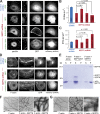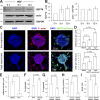Septins promote stress fiber-mediated maturation of focal adhesions and renal epithelial motility
- PMID: 25349260
- PMCID: PMC4210437
- DOI: 10.1083/jcb.201405050
Septins promote stress fiber-mediated maturation of focal adhesions and renal epithelial motility
Abstract
Organogenesis and tumor metastasis involve the transformation of epithelia to highly motile mesenchymal-like cells. Septins are filamentous G proteins, which are overexpressed in metastatic carcinomas, but their functions in epithelial motility are unknown. Here, we show that a novel network of septin filaments underlies the organization of the transverse arc and radial (dorsal) stress fibers at the leading lamella of migrating renal epithelia. Surprisingly, septin depletion resulted in smaller and more transient and peripheral focal adhesions. This phenotype was accompanied by a highly disorganized lamellar actin network and rescued by the actin bundling protein α-actinin-1. We show that preassembled actin filaments are cross-linked directly by Septin 9 (SEPT9), whose expression is increased after induction of renal epithelial motility with the hepatocyte growth factor. Significantly, SEPT9 overexpression enhanced renal cell migration in 2D and 3D matrices, whereas SEPT9 knockdown decreased migration. These results suggest that septins promote epithelial motility by reinforcing the cross-linking of lamellar stress fibers and the stability of nascent focal adhesions.
© 2014 Dolat et al.
Figures




References
Publication types
MeSH terms
Substances
Grants and funding
LinkOut - more resources
Full Text Sources
Other Literature Sources
Research Materials

